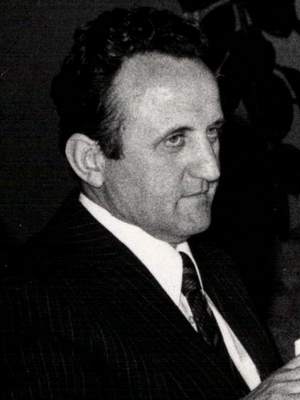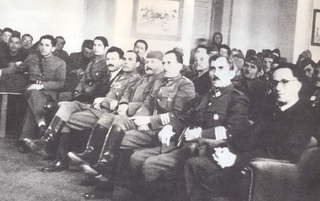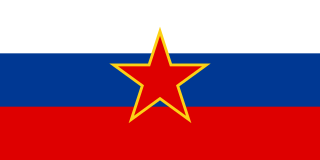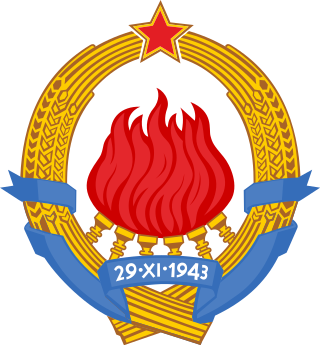
Montenegro is a country in Southeast Europe, located in the Balkans. It is bordered by Bosnia and Herzegovina to the north, Serbia to the northeast, Kosovo to the east, Albania to the southeast, and Croatia and the Adriatic Sea to the northwest with a coastline of 293.5 km. Podgorica is the country's capital and its largest city; it covers 10.4% of Montenegro's territory of 13,812 square kilometres (5,333 sq mi), and is home to roughly 31% of its total population of 621,000. Cetinje is the former royal capital and cultural centre of Montenegro and is the location of several national institutions, including the official residence of the President of Montenegro.
The Democratic Party of Socialists of Montenegro is a social-democratic and populist political party in Montenegro. A former long-time ruling party sitting at the opposition for the first time as of 2020, it was formed on 22 June 1991 as the successor of the League of Communists of Montenegro, which had governed Montenegro within the Socialist Federal Republic of Yugoslavia since World War II, and has remained a major force in the country ever since. The party is a member of the Socialist International and the Progressive Alliance, and an associate of the Party of European Socialists. During the 1990s, DPS was the major centre-left, social-democratic party in favour of Serbian-Montenegrin unionism. However, since 1997, the party has embraced Montenegrin independence and has been improving ties with the West, slowly turning into a catch-all party embracing Atlanticism, Montenegrin nationalism, neoliberalism, and pro-Europeanism.

"Muslims" is a designation for the ethnoreligious group of Serbo-Croatian-speaking Muslims and people of Muslim heritage, inhabiting mostly the territory of the former Socialist Federal Republic of Yugoslavia. The term, adopted in the 1971 Constitution of Yugoslavia, groups together a number of distinct South Slavic communities of Islamic ethnocultural tradition. Prior to 1993, a vast majority of present-day Bosniaks self-identified as ethnic Muslims, along with some smaller groups of different ethnicity, such as Gorani and Torbeši. This designation did not include Yugoslav non-Slavic Muslims, such as Turks, some Romani people and majority of Albanians.

The League of Communists of Slovenia was the Slovenian branch of the League of Communists of Yugoslavia, the sole legal party of Yugoslavia from 1945 to 1990. It was established in April 1937 as the Communist Party of Slovenia and was the first autonomous sub-national branch of the federal party. Its initial autonomy was further amplified with the Yugoslav constitution of 1974, which devolved greater power to the various republic level branches.

The prime minister of Montenegro, officially the president of the Government of Montenegro, is the head of the government of Montenegro. The role of the prime minister is to direct the work of the government, and to submit to the Parliament the government's program, which includes a list of proposed ministers. The resignation of the prime minister would cause the dissolution of his government.

The prime minister of Yugoslavia was the head of government of the Yugoslav state, from the creation of the Kingdom of Serbs, Croats and Slovenes in 1918 until the breakup of the Socialist Federal Republic of Yugoslavia in 1992.

Veselin Đuranović was a Yugoslav communist politician who served as President of the Presidency of Yugoslavia from 1984 to 1985. He also served as President of the Presidency of SR Montenegro from 1982 to 1983. Đuranović previously succeeded Džemal Bijedić as Prime Minister of Yugoslavia in 1977 following his death, serving until 1982.

Marko Orlandić was a high-ranking Montenegrin politician in the Socialist Federal Republic of Yugoslavia (SFRY) during the 1970s and '80s. He was born in Seoca, Yugoslavia.

The Socialist Republic of Montenegro, commonly referred to as Socialist Montenegro or simply Montenegro, was one of the six republics forming the Socialist Federal Republic of Yugoslavia and the nation state of the Montenegrins. It is a predecessor of the modern-day Montenegro.

The Socialist Republic of Serbia, previously known as the People's Republic of Serbia, commonly abbreviated as Republic of Serbia, was one of the six constituent republics of the Socialist Federal Republic of Yugoslavia in what is now the modern day states of Serbia and the disputed territory of Kosovo. Its formation was initiated in 1941, and achieved in 1944–1946, when it was established as a federated republic within Yugoslavia. In that form, it lasted until the constitutional reforms from 1990 to 1992, when it was reconstituted, as the Republic of Serbia within the Federal Republic of Yugoslavia. It was the largest constituent republic of Yugoslavia, in terms of population and territory. Its capital, Belgrade, was also the federal capital of Yugoslavia.

Veljko Milatović was a Montenegrin Communist partisan, politician, statesman serving once as the Speaker and twice as President.

The State Anti-fascist Council for the National Liberation of Montenegro and Boka was formed as the highest governing institution of the anti-fascist resistance movement in Montenegro, in the former Kingdom of Yugoslavia.

The Montenegrin Federalist Party, sometimes known simply as the Montenegrin Party, was a Montenegrin political party in the Kingdom of Yugoslavia which stood for preservation of Montenegrin autonomy and a decentralized federalised Yugoslavia. It pursued the ideology of the Greens who lost the Christmas Uprising, but in a peaceful and democratic manner. Its best known leader was Sekula Drljević.

The Socialist Republic of Slovenia, commonly referred to as Socialist Slovenia or simply Slovenia, was one of the six federal republics forming Yugoslavia and the nation state of the Slovenes. It existed under various names from its creation on 29 November 1945 until 25 June 1991.

The Presidency of the Socialist Federal Republic of Yugoslavia was the collective head of state of the Socialist Federal Republic of Yugoslavia. It was established in 1971 according to amendments to the 1963 Constitution and reorganized by the 1974 Constitution. Up to 1974, the Presidency had 23 members – three from each republic, two from each autonomous province and President Josip Broz Tito. In 1974 the Presidency was reduced to 9 members – one from each republic and autonomous province and, until 1988, President of the League of Communists of Yugoslavia ex officio.

The Parliament of Yugoslavia was the legislature of Yugoslavia. Before World War II in the Kingdom of Yugoslavia it was known as the National Assembly, while in the Socialist Federal Republic of Yugoslavia the name was changed to Federal Assembly. It functioned from 1920 to 1992 and resided in the building of the House of the National Assembly which subsequently served as the seat of the Parliament of Serbia and Montenegro and since 2006 hosts the National Assembly of Serbia. The Federal Assembly was the highest organ of state power and the only branch of government in the country, with all state organs subservient to it under the principle of unified power as it was a one-party state, with the League of Communists of Yugoslavia as the sole legal party in the country. Most of the Federal Assembly's actions simply rubber stamp the party's decisions.

Montenegrin nationalism is the nationalism that asserts that Montenegrins are a nation and promotes the cultural unity of Montenegrins.

The League of Communists of Kosovo was the Kosovo branch of the League of Communists of Yugoslavia, the sole legal party of Yugoslavia from 1945 to 1990.

The president was the leader of the League of Communists of Montenegro (LCM), the ruling party of the Socialist Republic of Montenegro (SRM) in the Socialist Federal Republic of Yugoslavia. Party rules stipulated that the LCM Central Committee elected the president. Moreover, the Central Committee was empowered to remove the president. The president served ex officio as a member of the Presidency of the Central Committee of the League of Communists of Yugoslavia (LCY) and of the SRM Presidency. To be eligible to serve, the president had to be a member of the Presidency of the LCM Central Committee. The 8th LCM Congress instituted a two-year term limits for officeholders.

Radoje Pajović was a Yugoslav and Montenegrin historian who worked at the Institute of History at the University of Montenegro for forty years. He has been dubbed "the most prominent Montenegrin historian" of events in Montenegro during World War II by the Montenegrin historian Srđa Pavlović, and Professor Kenneth Morrison, author of the 2009 book Montenegro: A Modern History, asserts that Pajović is one of the most prominent Montenegrin historians in general.


















